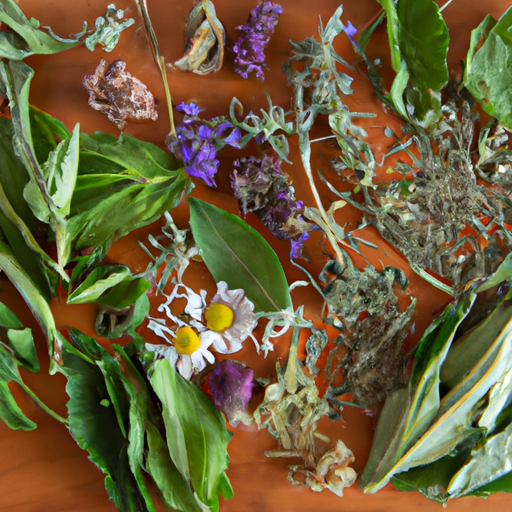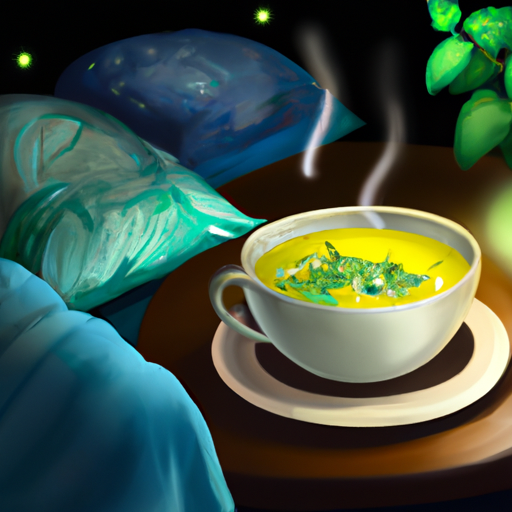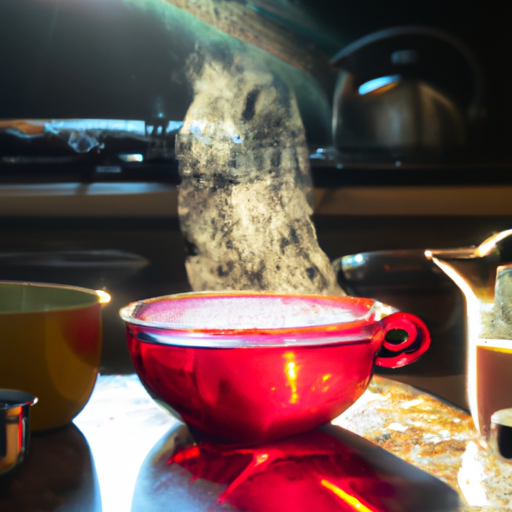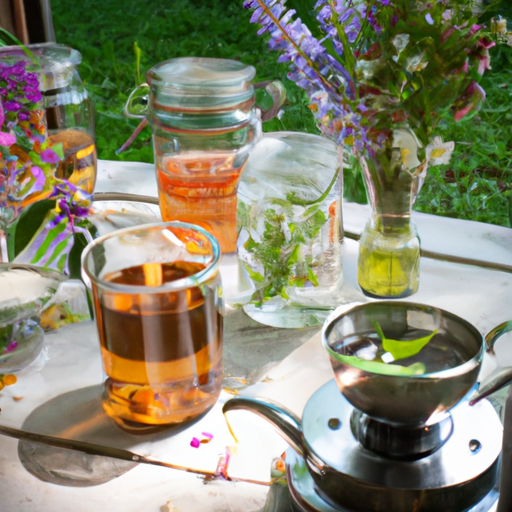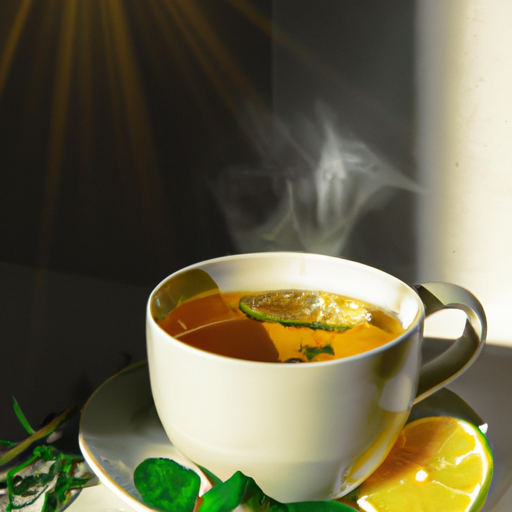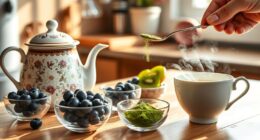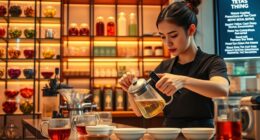You may be familiar with the classic phrase that a nice cup of tea can calm the mind. Let me assure you, it is indeed accurate. Being a fan of tea myself, I have found great joy and therapeutic benefits in creating my own herbal tea blends from the beginning.
There’s something incredibly satisfying about plucking fresh leaves, drying them, and then mixing them with aromatic spices to create a personalized elixir that warms both the body and the spirit.
In this article, I will guide you through the art of making your own herbal tea blends from the leaves. From selecting the perfect base tea leaves to gathering an array of fresh herbs and spices, we will explore each step in detail.
I’ll also share tips on drying and preparing your ingredients, as well as expert advice on blending and storing your creations.
So, if you’re ready to embark on a journey of flavor and wellness, join me in unlocking the secrets to creating your very own homemade tea blends. Get ready to brew, sip, and savor the delightful magic that awaits.
Key Takeaways
- Select a base tea leaf that aligns with your desired flavor profile, such as green tea for a light and delicate taste or black tea for a strong and bold flavor.
- Gather fresh herbs and spices, harvesting them in the morning for maximum flavor and potency. Research the medicinal benefits of each herb or spice to create a well-rounded blend.
- Properly dry the herbs and spices using methods like air drying, oven drying, or a food dehydrator. This ensures that they retain their flavor and potency.
- Experiment with different proportions and ratios of herbs and spices to create a well-balanced blend. Grinding the leaves into a fine powder using a mortar and pestle or blender can help to evenly distribute the flavors.
Select Your Base Tea Leaves
Now it’s time for you to choose your base tea leaves to create your own unique herbal tea blend. Choosing the right base tea leaves for your herbal blends is crucial in achieving the desired flavor. Each tea leaf has its own distinct flavor profile, which will contribute to the overall taste of your blend.
Understanding the flavor profiles of different tea leaves will help you make an informed decision. For a lighter and more delicate flavor, opt for green tea leaves. If you prefer a stronger and bolder taste, black tea leaves are a great choice. Oolong tea leaves offer a balance between green and black tea, with a slightly fruity and floral note. White tea leaves provide a subtle and mellow flavor.
Now that you have selected your base tea leaves, it’s time to gather fresh herbs and spices to enhance your blend.
Gather Fresh Herbs and Spices
To enhance the flavors of your homemade brew, seek out the freshest herbs and spices available. When it comes to gathering fresh herbs and spices for your herbal tea blends, it’s important to consider harvesting techniques and the medicinal benefits they offer.
Harvesting herbs should be done in the morning, after the dew has dried, to ensure maximum flavor and potency. Gently pluck the leaves or flowers, being careful not to damage the plant. Spices like cinnamon and ginger can be harvested by digging up the roots or cutting off the stems. Remember to research the specific medicinal benefits of each herb or spice you choose to incorporate into your tea blend. This will help you create a brew that not only tastes delicious but also promotes wellness.
Now, let’s move on to how to dry and prepare your ingredients for the perfect cup of herbal tea.
Dry and Prepare Your Ingredients
After harvesting the freshest herbs and spices, it’s essential to carefully dry and prepare them to unlock their full flavors and medicinal properties. To preserve herbs for long term use, there are several alternative methods of drying herbs that you can try.
-
Air drying: Hang bundles of herbs upside down in a warm, well-ventilated area until they are completely dry.
-
Oven drying: Spread the herbs on a baking sheet and place them in a low-temperature oven until they become crisp.
-
Dehydrator: Use a food dehydrator to remove the moisture from the herbs and preserve their flavors.
By drying your herbs properly, you can ensure that they retain their potency and flavor for a longer period of time.
Once your herbs and spices are dried, you can move on to the exciting step of mixing and blending your ingredients to create unique and delicious herbal tea blends.
Mix and Blend Your Ingredients
When it comes to mixing and blending your herbal tea ingredients, two key points to keep in mind are proportions and ratios. Getting the right balance of each ingredient is crucial for achieving the desired flavor and benefits.
Additionally, choosing the right tool for the job is important, whether it’s a mortar and pestle for a more traditional approach or a blender for a quicker and more efficient process.
By understanding these factors, you can create your own unique and delicious herbal tea blends with ease.
Proportions and Ratios
For a well-balanced and harmonious blend of herbal tea, consider experimenting with different proportions and ratios of leaves to create a unique and personalized infusion.
Proper measurements are essential when it comes to achieving the desired flavors and medicinal properties. Start by selecting the primary ingredient, which will be the base of your blend, and then add smaller quantities of complementary herbs and spices. This allows you to highlight certain flavors while ensuring that none overpower the others.
Be creative and open-minded, as you may discover unexpected combinations that work beautifully together.
To make the process easier, you can use a mortar and pestle or blender to grind the leaves into a fine powder, which will help release the full flavor and aroma.
Use a Mortar and Pestle or Blender
To enhance the depth and complexity of your infusion, consider utilizing a mortar and pestle or blender to easily grind the herbs and spices into a fine powder, intensifying the release of their full flavors and enticing aromas.
- Mortar and pestle vs. blender: pros and cons:
- Mortar and pestle: This traditional method allows for more control over the texture and consistency of the blend. It also helps to retain the aromatic oils, resulting in a more fragrant tea.
- Blender: Using a blender can save time and effort, especially when dealing with larger quantities of herbs. It ensures a consistent grind and is perfect for quickly blending coarse ingredients.
Alternative methods for blending herbal tea leaves:
- Coffee grinder: This electric appliance can effectively grind herbs into a fine powder, similar to a blender.
- Food processor: If you don’t have a blender or mortar and pestle, a food processor can also do the job, although it may not provide as fine a grind.
To store and age your blends, you can transfer them to airtight containers and keep them in a cool, dark place. This allows the flavors to meld together and develop over time, resulting in a more harmonious and flavorful cup of tea.
Store and Age Your Blends
When it comes to storing and aging your herbal tea blends, there are a few key points to consider.
First, it’s important to choose proper storage containers that will keep your blends fresh and protected from moisture and light.
Second, allowing the flavors to develop over time is crucial for creating a more complex and enjoyable tea experience.
Lastly, finding a cool, dark place to store your blends will help maintain their optimal freshness and flavor.
Proper Storage Containers
One important aspect of making your own herbal tea blends is choosing the right storage containers, such as airtight jars or tins, to keep your leaves fresh and flavorful.
Storing techniques and preserving freshness are key to ensuring that your blends maintain their quality over time. Airtight containers help to protect the leaves from moisture, light, and air exposure, which can degrade the flavor and potency of the herbs.
Glass jars are a popular choice as they allow you to admire the vibrant colors of your blends while also providing an airtight seal. Alternatively, metal tins are great for blocking out light and keeping the leaves in a cool, dark place.
By properly storing your blends, you allow the flavors to develop and intensify, resulting in a more satisfying cup of tea.
Allowing the Flavors to Develop
Now that we’ve discussed the importance of proper storage containers for your herbal tea blends, let’s move on to the next step: allowing the flavors to develop.
This is a crucial part of the process as it infuses the flavors of the herbs and spices into the tea leaves. One way to do this is by using heat. By gently heating the tea leaves, you can coax out their natural oils and flavors, resulting in a more robust and aromatic cup of tea.
Another factor to consider is experimenting with different steeping times. Some teas may only need a few minutes to develop their flavors, while others may require a longer steeping time. It’s all about finding the perfect balance for your taste preferences.
So, now that we’ve allowed the flavors to develop, it’s time to brew and enjoy your homemade tea.
Brew and Enjoy Your Homemade Tea
To fully savor your homemade tea blends, start by brewing them using your favorite method and relish the delightful flavors. Whether you prefer steeping your leaves in a teapot, using a French press, or opting for a traditional tea infuser, the brewing technique you choose will affect the taste and aroma of your herbal tea.
Experiment with different steeping times and water temperatures to find the perfect balance. As you indulge in your cup of homemade herbal tea, take a moment to appreciate the health benefits it offers. From boosting your immune system to aiding digestion, each blend has its own unique properties.
So sit back, relax, and let the soothing properties of your homemade tea blend wash over you.
In the next section, we will explore how you can share and gift your blends to spread the joy of herbal tea.
Share and Gift Your Blends
Spread the joy of your delicious homemade tea blends by sharing them with friends and family, and watch as their taste buds explode with pure delight!
One way to make your tea blends even more special is by using creative packaging ideas. You can use small glass jars, cute tin containers, or even colorful muslin bags to package your blends. Add a personalized label and a handwritten note to make it extra special.
Not only will your loved ones enjoy the taste of your blends, but they will also benefit from the health benefits of homemade herbal tea blends. Each blend can be customized to target specific health concerns, such as soothing an upset stomach or boosting the immune system.
Share the goodness of your homemade blends and spread happiness to those around you!
Frequently Asked Questions
Can I use any type of tea leaves as a base for my herbal tea blends?
Yes, you can use non tea leaves as a base for herbal tea blends. However, using specific types of tea leaves, like green tea or chamomile, can provide added benefits such as antioxidants or soothing properties.
How long should I dry the herbs and spices before using them in my blend?
To achieve the optimal drying time for herbs and spices in my blend, it is crucial to allow them to dry completely. This ensures the preservation of their flavors and aromas, enhancing the overall quality of the tea.
Can I use store-bought tea leaves instead of gathering fresh ones for my blends?
Yes, you can use store-bought tea leaves in your blends. However, the freshness of homemade blends using freshly gathered leaves is unmatched. So, if possible, I would recommend using fresh leaves for the best flavor and aroma.
How should I store my herbal tea blends to ensure they stay fresh?
To ensure the freshness of homemade tea blends, store them in airtight containers in a cool, dark place. The shelf life of herbal tea blends is generally 6-12 months, but this can vary depending on the ingredients used.
Can I add sweeteners or other flavorings to my homemade tea blends?
Yes, you can add sweeteners and flavorings to your homemade tea blends. Adding sweeteners can enhance the taste, but it’s important to consider the pros and cons. Some options include honey, stevia, or even fruit slices. Experiment and find what works best for you.
Conclusion
In conclusion, creating your own herbal tea blends is a rewarding and satisfying experience. By carefully selecting your base tea leaves and gathering fresh herbs and spices, you can create unique flavors that cater to your personal taste preferences.
Don’t forget to properly dry and prepare your ingredients, as well as mix and blend them together for the perfect balance of flavors. Store and age your blends to enhance their taste, and finally, brew and enjoy your homemade tea.
So why not embark on this journey of tea creation and let your creativity flow with every sip?

